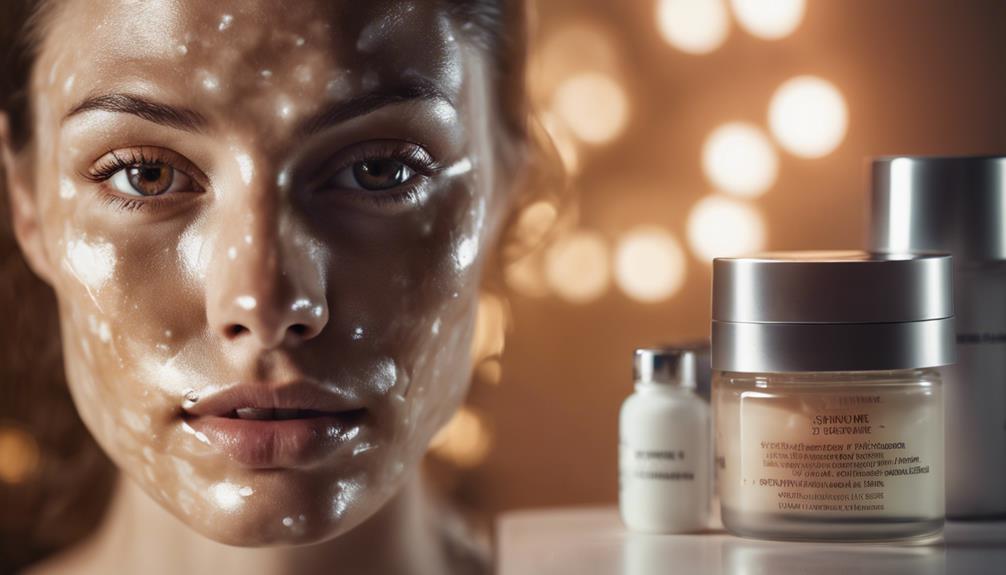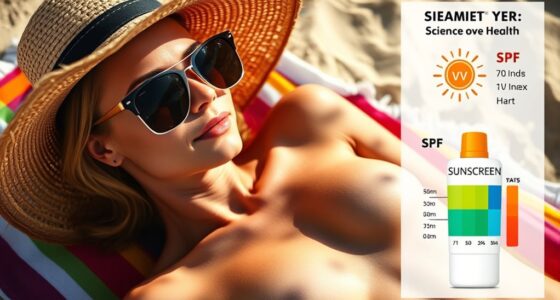Tanning beds aren't the safe alternative many think they are. They emit 3-6 times more UVA radiation than the sun, increasing your risk for skin cancer. Starting indoor tanning before age 20 raises melanoma risk by 47%. Plus, they don't help with vitamin D production since they primarily emit UVA rays. Long-term use accelerates skin aging, resulting in wrinkles and age spots. Many tanning salons mislead you about safety, further heightening risks. It's essential to understand the full truth now, as uncovering these realities can help you make healthier choices for your skin.
Key Takeaways
- Tanning beds emit significantly more UVA radiation than the sun, greatly increasing skin cancer risks, especially for young users.
- Using tanning beds offers minimal protection equivalent to SPF 3-4, which is inadequate for safe tanning.
- Indoor tanning contributes to premature skin aging, leading to wrinkles and age spots that outweigh any temporary aesthetic benefits.
- Tanning beds are ineffective for vitamin D production, primarily emitting UVA rays instead of the necessary UVB rays.
Myths Surrounding Tanning Beds
Many people believe common myths about tanning beds that can lead to serious health risks and misconceptions about safe tanning practices. One prevalent myth is that tanning beds are a safer alternative to sun exposure. In reality, these beds emit 3-6 times more UVA radiation than the sun, greatly increasing your risk of skin cancer. Instead of providing a protective base tan, using tanning beds only offers minimal protection, roughly equivalent to SPF 3-4. This misleading belief encourages you to expose your skin more, further heightening the risk of developing skin cancer.
Additionally, many people think tanning beds can help with vitamin D production. However, they primarily emit UVA rays, which don't contribute to vitamin D synthesis at all. You might also not realize that indoor tanning can lead to addiction-like behaviors. Many users experience anxiety or depression when they can't access UV exposure, resembling other behavioral addictions.
It's essential to debunk these myths and recognize the real dangers associated with tanning beds. Prioritizing your skin health means staying informed and making safer choices for your tanning practices.
Health Risks of Indoor Tanning

When you step into a tanning bed, you're exposing yourself to UV radiation that can greatly raise your risk of skin cancer, especially if you start young.
Not only does this increase your chances of melanoma and other skin cancers, but it also accelerates the aging of your skin.
Understanding these health risks is essential for making informed choices about your tanning habits.
Skin Cancer Risks
Using tanning beds greatly heightens your risk of skin cancer, especially if you start before turning 20. Research shows that using tanning beds before this age raises your melanoma risk by a staggering 47%. Not only that, but indoor tanning increases your risk of developing squamous cell carcinoma by 58% and basal cell carcinoma by 24%.
Each time you lie in a tanning bed, the UV radiation damages your skin cells' DNA, which contributes to skin cancer over time. This risk isn't just limited to tanning beds; even a single blistering sunburn in your youth can nearly double your lifetime risk of melanoma. The connection between UV exposure and skin cancer is undeniable.
If you're currently using tanning beds, consider the long-term implications on your health. Quitting indoor tanning can greatly lower your risk of developing skin cancer, as your skin begins to repair itself once exposure stops.
It's essential to understand the serious health risks associated with tanning beds and make informed choices about your skin's safety. Prioritize your health by opting for safer alternatives to achieve that sun-kissed glow.
Aging Effects
Indoor tanning accelerates skin aging, leading to wrinkles and age spots that can make you look older than you are. Tanning beds expose your skin to harmful UV rays, causing skin damage that can result in an aged appearance far sooner than if you'd avoided them.
Here are some alarming aging effects you should consider:
- Premature Wrinkles: Regular tanning can leave your skin leathery and wrinkled before its time.
- Loss of Firmness: Frequent exposure to UV light can cause your skin to lose its elasticity, leading to sagging.
- Visible Age Spots: These dark patches can appear earlier and more prominently due to indoor tanning.
- Increased Skin Cancer Risk: Each tanning session raises your chances of developing skin cancer, especially if you start before 35.
All these factors contribute to the harsh reality of aging effects linked to tanning beds.
While a bronze glow may seem appealing, the long-term consequences on your skin health are far more significant. Consider the toll it takes on your appearance and well-being before stepping into that tanning bed.
Understanding Skin Cancer

Tanning beds pose a serious threat to your skin, greatly increasing the risk of developing skin cancer, particularly melanoma. Studies show that using tanning beds before age 20 raises your risk of melanoma by 47%. This alarming statistic underscores the health risks associated with indoor tanning.
Tanning beds emit 3-6 times more UVA radiation than natural sunlight, which notably contributes to skin damage and elevates your cancer risk. Additionally, a single blistering sunburn during your youth can nearly double your lifetime risk of melanoma.
With nearly 5 million people in the U.S. treated for skin cancer annually, the rise in cases over the past decade is largely attributed to UV exposure from both the sun and tanning beds. The financial burden is also staggering, with treatment costs for skin cancer exceeding $8 billion annually in the U.S.
Understanding the direct link between tanning beds and skin cancer is essential. By recognizing the risks associated with UV exposure, you can make informed decisions about your tanning habits and prioritize your skin's health.
Effects of Tanning on Aging

Frequent exposure to UV radiation accelerates skin aging, leading to wrinkles, fine lines, and age spots. When you indulge in tanning, whether indoors or out, you're not just chasing a bronzed look; you're risking your skin's future. The effects of tanning can be more severe than you think.
Here are four alarming impacts of UV exposure on aging:
- Wrinkles and Fine Lines: The breakdown of collagen results in premature wrinkles, making you look older than your years.
- Leathery Skin: Regular tanning can leave your skin looking rough and leathery, stripping it of its natural softness.
- Loss of Elasticity: Your skin loses firmness and elasticity, leading to sagging that can be hard to reverse.
- Age Spots: Increased UV exposure can lead to dark spots, giving your skin an uneven tone.
It's vital to recognize that the damage from tanning isn't just superficial; it can have lasting effects on your skin's quality and youthfulness.
Prioritizing skin health is essential to avoid the harsh realities of aging prematurely.
Safe Alternatives to Tanning

Finding safe alternatives to achieve that sun-kissed glow can help you protect your skin from the damaging effects of UV exposure while still looking radiant.
Sunless tanning products, like sprays and lotions containing dihydroxyacetone (DHA), offer a fantastic solution. They give you a beautiful tan without the risks associated with tanning beds.
If you need a quick boost for a special occasion, bronzers can enhance your skin tone temporarily, providing that sought-after glow without any UV exposure.
Remember, though, that self-tanning products don't offer sun protection, so it's essential to continue using broad-spectrum sunscreen when using these types of products.
Embracing your natural skin tone can also promote self-acceptance and confidence, which can reduce the urge to seek out tanning altogether.
To maintain your skin health, incorporate an all-encompassing skincare routine, including regular moisturizing. This guarantees your skin stays hydrated and radiant, even without tanning.
Vitamin D and Sun Exposure

Sun exposure is essential for natural vitamin D synthesis, but not all UV rays contribute equally to this process.
Only UVB rays are effective for vitamin D production, and unfortunately, most tanning beds primarily emit UVA rays. This means relying on tanning beds for your vitamin D needs isn't just ineffective; it also carries significant health risks, including an increased chance of skin cancer.
To emphasize the importance of proper sun exposure and vitamin D, consider these points:
- Just 15 minutes of sun exposure can meet your vitamin D requirements.
- Dietary sources like fatty fish and fortified products can also provide necessary vitamin D.
- Overexposure to UV rays from tanning beds can lead to long-term skin damage.
- Sun safety is vital, and you can achieve a healthy glow with sunless tanning products.
Balancing your vitamin D needs with sun safety is key.
Instead of risking your health in a tanning bed, focus on safe sun exposure or opt for dietary supplements to maintain healthy vitamin D levels without the dangers of UV radiation.
Addiction to Tanning

You mightn't realize that tanning can become an addiction, with symptoms that mirror those of substance dependency.
When you can't tan, feelings of anxiety or depression may creep in, affecting your emotional well-being.
Understanding these dependency symptoms is essential to recognizing the potential risks associated with frequent tanning.
Tanning Dependency Symptoms
Tanning dependency can lead to noticeable withdrawal symptoms, such as anxiety or depression, when individuals can't get their regular dose of UV exposure. This compulsive behavior often pushes people to prioritize tanning over essential activities, even when they know the risks involved.
Health experts emphasize that this addiction isn't just about aesthetics; it's about a psychological need that can have serious health repercussions.
Here are some common symptoms of tanning dependency:
- Cravings for UV exposure: You might find yourself constantly thinking about your next tanning session.
- Neglecting responsibilities: Tanning could interfere with your daily tasks or social life.
- Compulsive behavior: You may feel a strong urge to tan despite being aware of the increased risk of skin cancer.
- Emotional distress: Anxiety or irritability may arise if you can't access tanning beds.
Recognizing these symptoms is vital. Ignoring them can lead to severe long-term skin damage and greatly increase your risk of skin cancer.
Understanding tanning dependency can help you take proactive steps toward healthier choices.
Emotional Effects of Tanning
The emotional toll of tanning addiction can greatly impact self-esteem and body image, compelling individuals to chase an idealized look at the expense of their long-term health. You might find yourself drawn to tanning beds, believing that a bronzed skin tone will boost your confidence. However, this desire often stems from societal beauty standards heavily promoted by the tanning industry, particularly targeting young women.
As you continue to seek that perfect tan, the emotional effects of tanning addiction can become overwhelming. You could experience withdrawal symptoms when you stop tanning, similar to those seen in substance addictions. This compulsive behavior can lead to increased anxiety and depression, especially when you're away from UV light.
Despite being aware of the health risks associated with tanning—like skin damage and higher chances of skin cancer—approximately 30% of indoor tanners show signs of addiction. The pressure to maintain a tanned appearance can overshadow your well-being, leaving you in a cycle that harms both your skin and your mental health.
It's vital to recognize these patterns and consider healthier alternatives for self-esteem and body image.
Misleading Salon Information

Many salons downplay the risks of indoor tanning, leading customers to overlook the serious health hazards associated with UV exposure. This misleading information can be detrimental, especially for young women who are often targeted by tanning salons.
Here are four alarming facts you should know:
- 90% of tanning salon staff deny health risks, perpetuating a false sense of safety.
- Many salons promote false health benefits, encouraging you to underestimate the dangers.
- Salon employees often lack accurate knowledge, spreading misleading information about tanning.
- Deceptive marketing tactics emphasize aesthetics over your well-being, leading to harmful tanning behaviors.
The reality is that the health risks of indoor tanning are significant, ranging from skin damage to increased cancer risk. By downplaying these dangers, tanning salons create a false narrative that can put your health at risk.
It's essential to stay informed and critically evaluate the information presented by these establishments. When considering indoor tanning, remember that the allure of a bronzed look shouldn't overshadow your long-term health.
Make informed choices, and prioritize your safety over superficial beauty.
Importance of Public Education

Public education plays an essential role in raising awareness about the hidden dangers of indoor tanning and combating the myths that lead to risky behaviors. Many people, especially teenagers, still underestimate the health risks associated with tanning beds. Misconceptions like the idea that a 'base tan' can protect you persist, making it important to address these inaccuracies through effective education campaigns.
When schools and communities actively inform youth about the dangers of tanning beds, they can greatly reduce usage rates. For instance, educational initiatives have cut high school indoor tanning rates from nearly 16% in 2009 to just over 7% in 2015.
Additionally, many tanning salon employees lack proper training and deny any health risks, which only adds to the confusion. Ongoing public education efforts are critical in dispelling myths and ensuring individuals understand the serious implications of using tanning beds.
Frequently Asked Questions
Does Tanning in a Tanning Bed Have Any Benefits?
Tanning in a tanning bed doesn't offer any real benefits. It exposes you to harmful UVA rays, increases your skin cancer risk, and doesn't provide the vitamin D your body needs. It's not worth the risk.
How Much Worse Is a Tanning Bed Than the Sun?
Tanning beds are considerably worse than the sun, emitting 3-6 times more UVA radiation. This heightened exposure increases your risk of skin cancer and causes immediate DNA damage, jeopardizing your long-term skin health.
Are There Any Health Benefits to Sunbeds?
Imagine a sunlit room filled with warmth; that's not what sunbeds provide. You won't find real health benefits in tanning beds. Instead, you risk skin cancer and other issues, overshadowing any temporary glow you might achieve.
Do Tanning Beds Expose You to Harmful UV Rays?
Yes, tanning beds expose you to harmful UV rays. They emit considerably more UVA radiation than the sun, increasing your risk of skin cancer and causing DNA damage with each session. It's vital to take into account these dangers.
Are Tanning Beds Really Linked to an Increased Risk of Skin Cancer?
Many scientific studies have shown the truth about skin cancer: tanning beds are indeed linked to an increased risk of developing it. The intense UV radiation from tanning beds can damage the skin, leading to a higher likelihood of developing skin cancer. It’s important to protect your skin from harmful UV rays.
Conclusion
In the end, it's essential to peel back the layers of misinformation surrounding tanning beds.
While the allure of a sun-kissed glow may tempt you, the hidden dangers can leave lasting scars on your health.
Choosing safer alternatives and staying informed can help you shine brightly without compromising your well-being.
Remember, embracing your natural skin tone isn't just beautiful; it's a powerful statement of self-love and awareness in a world that often values the superficial.









